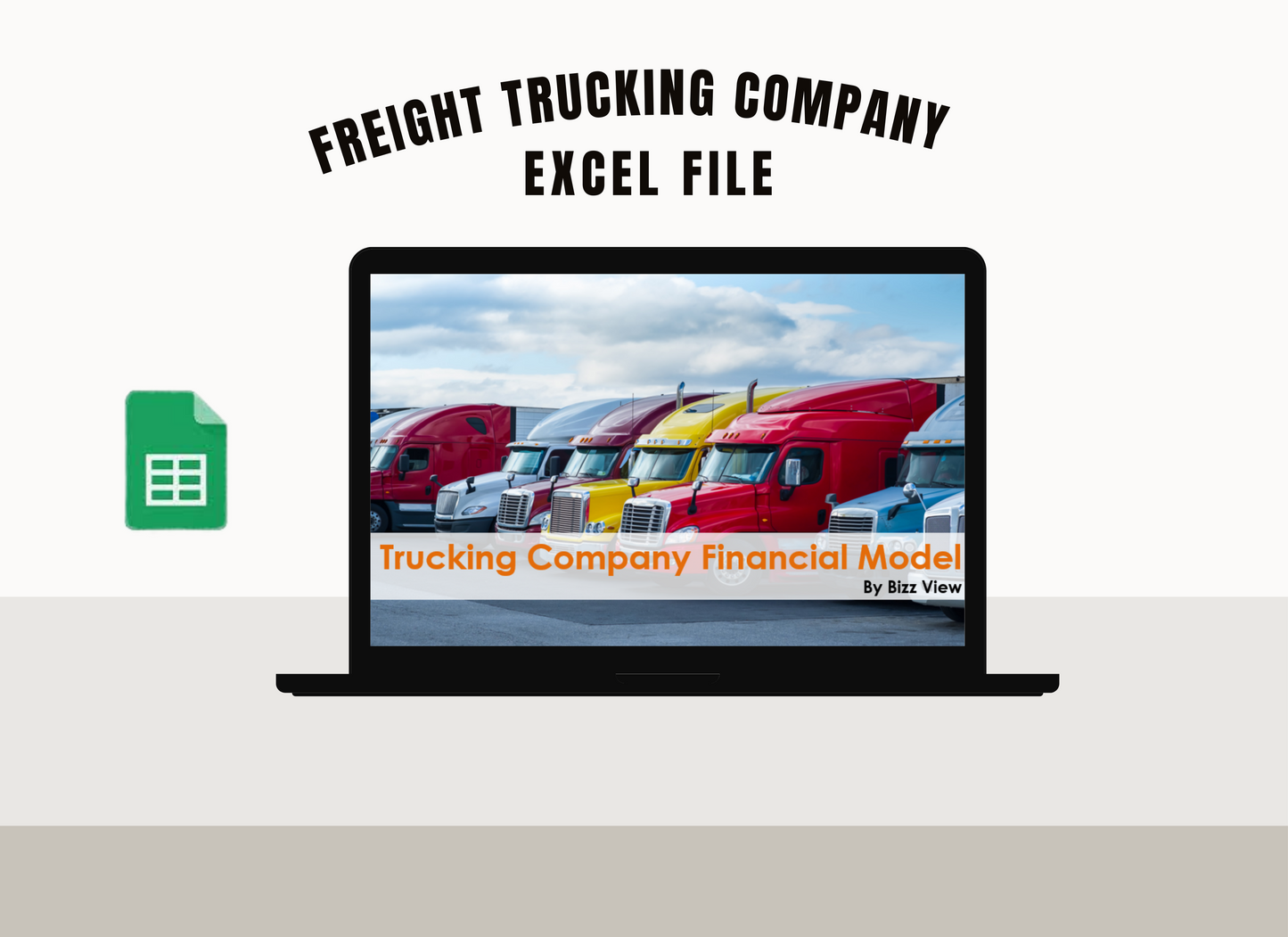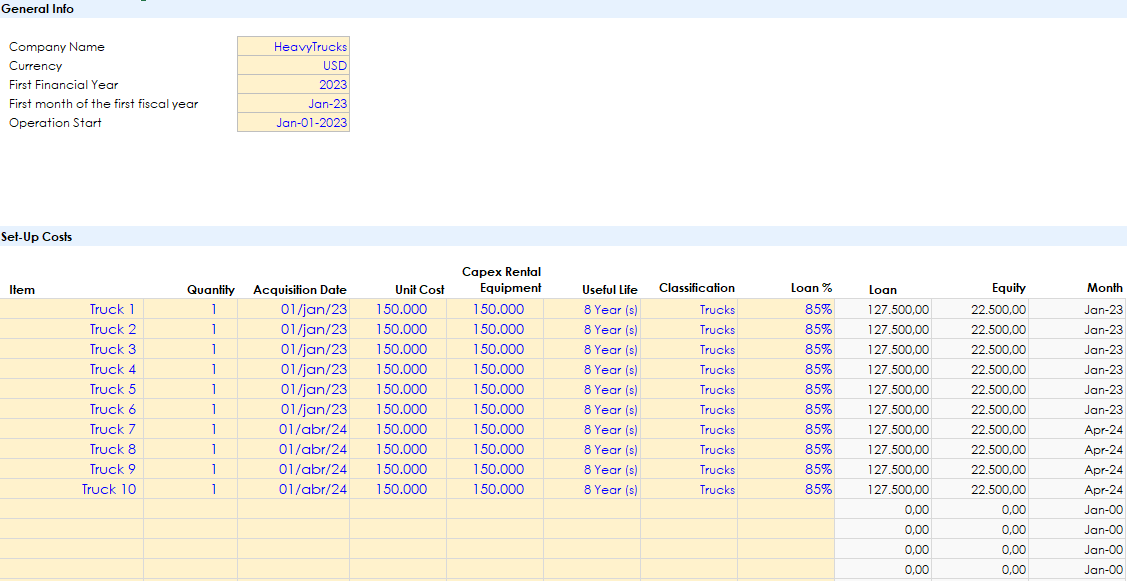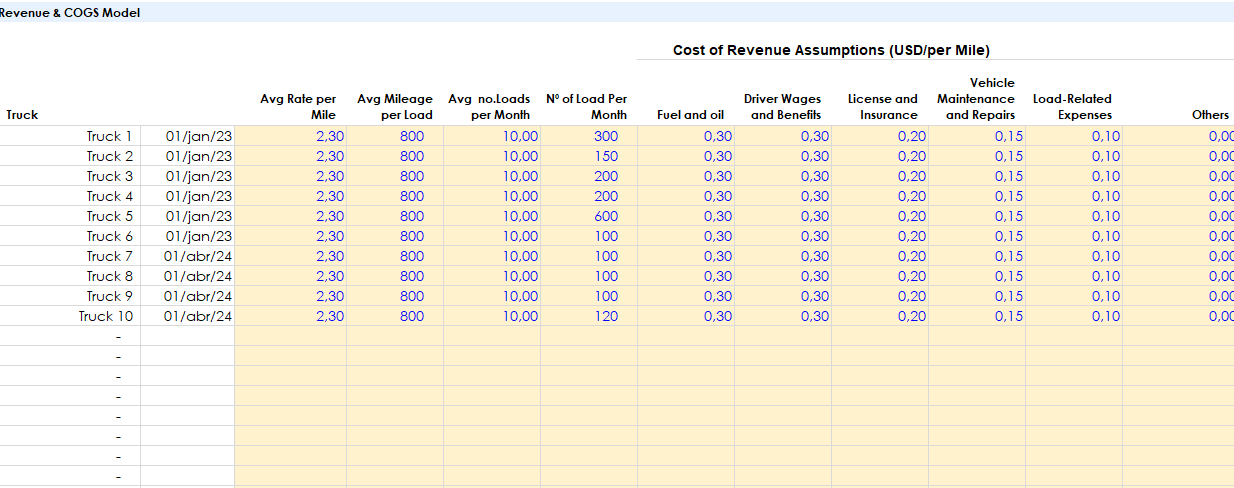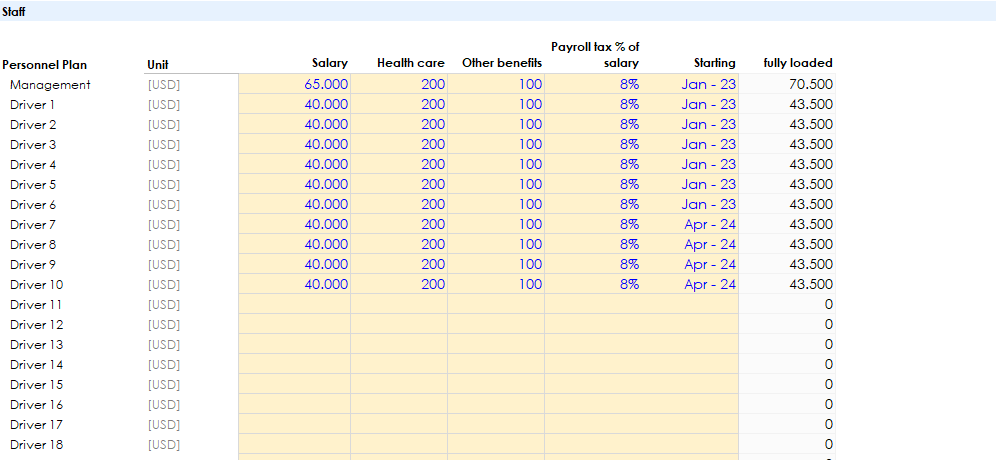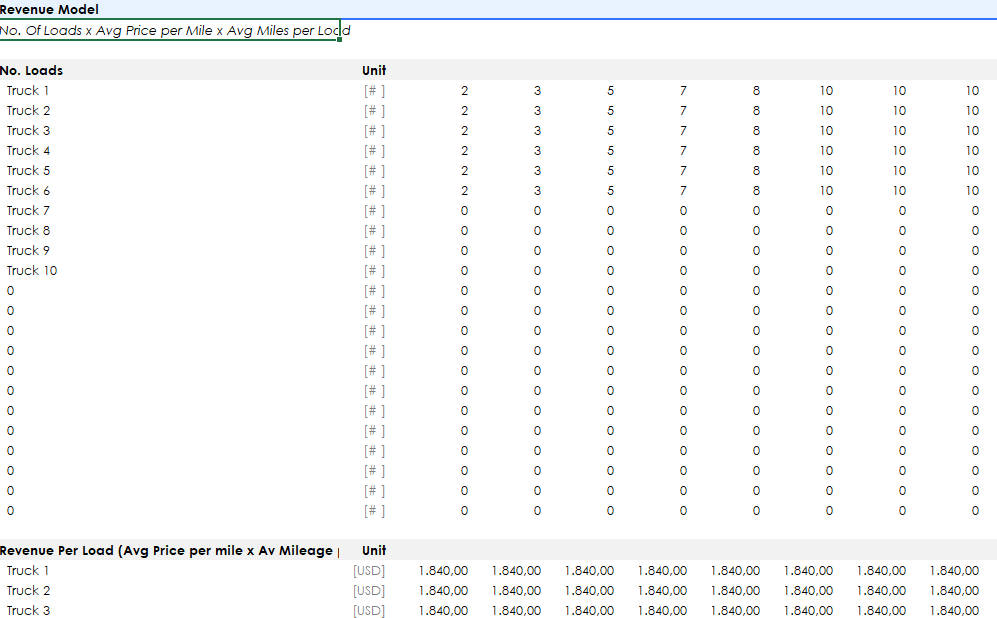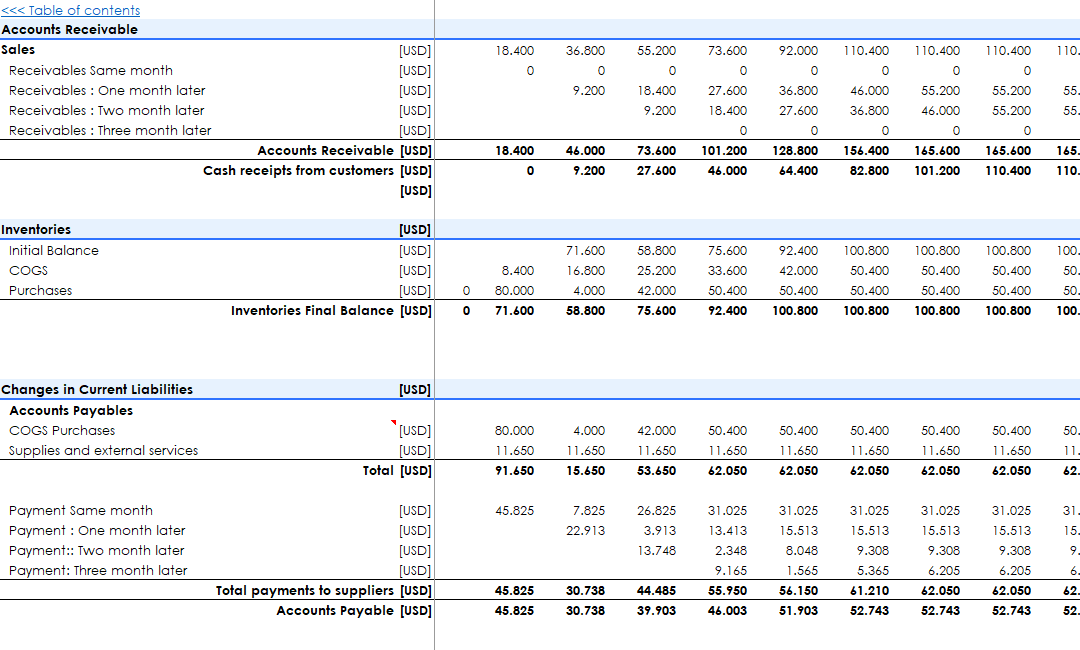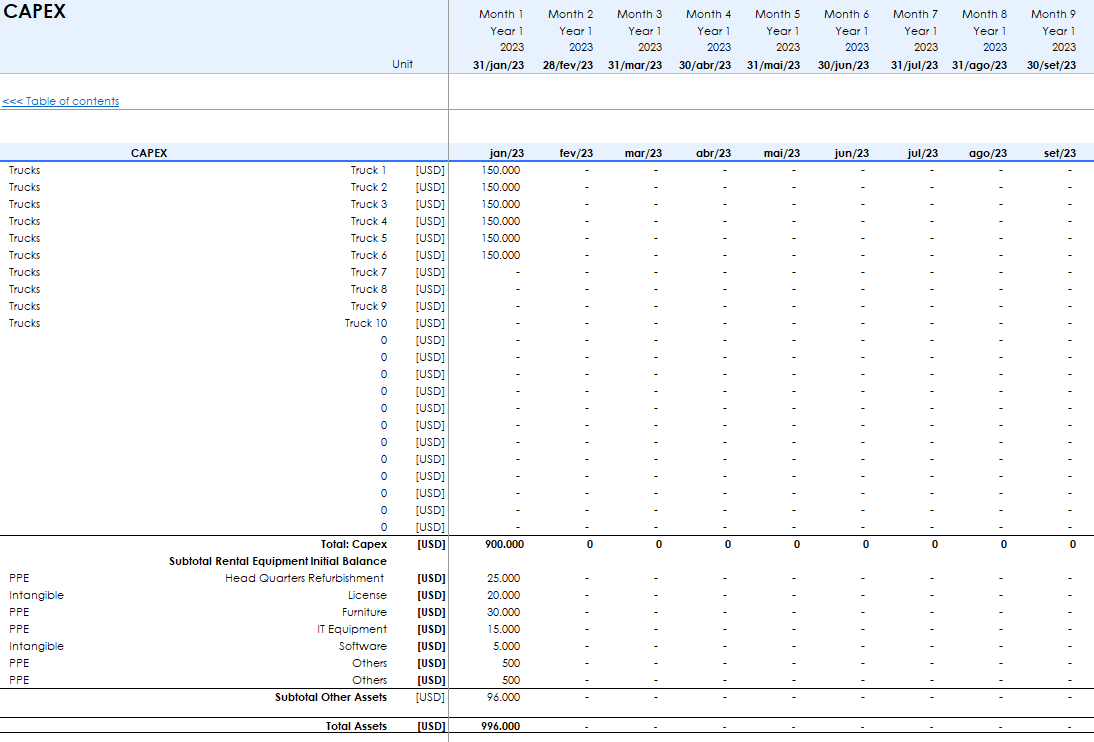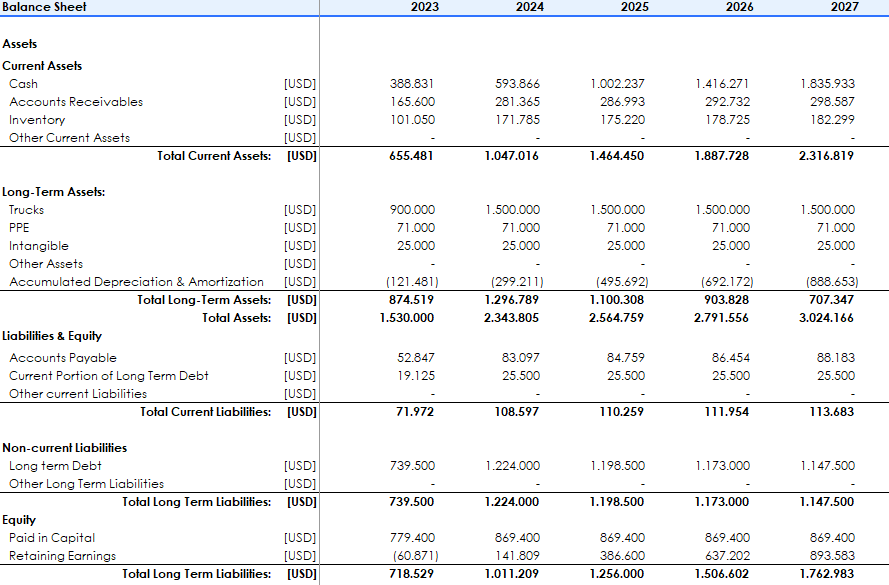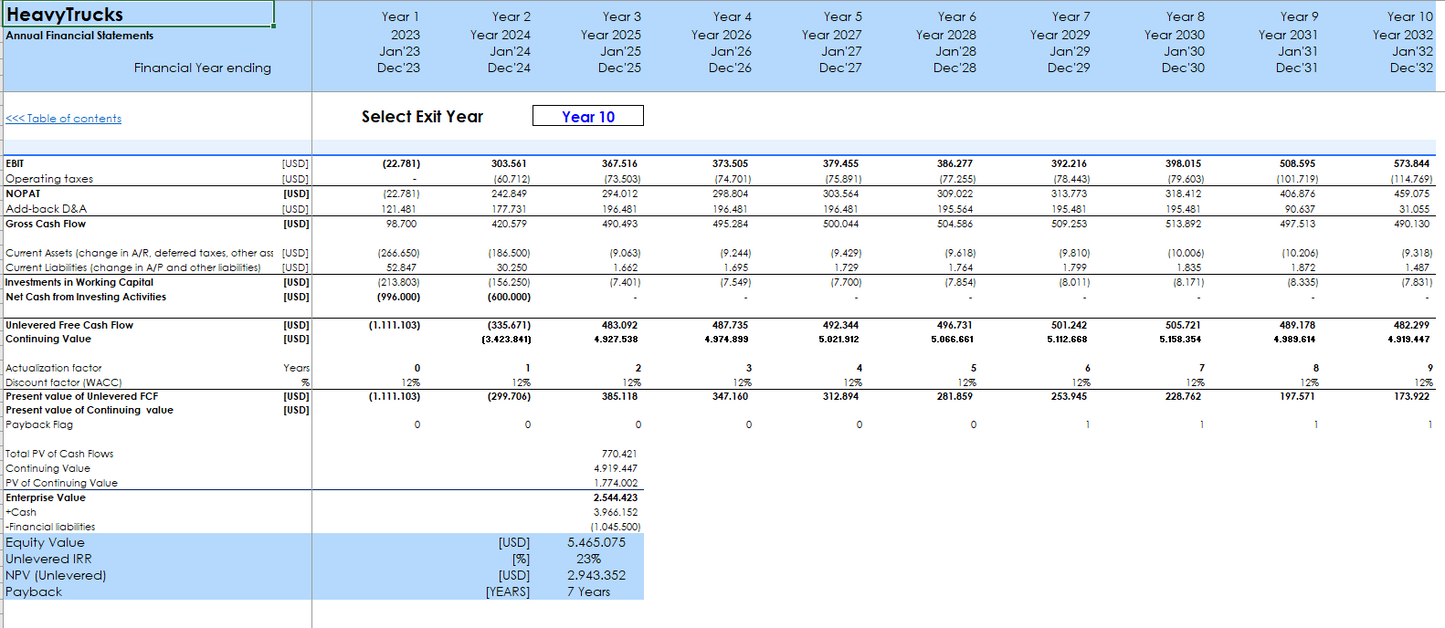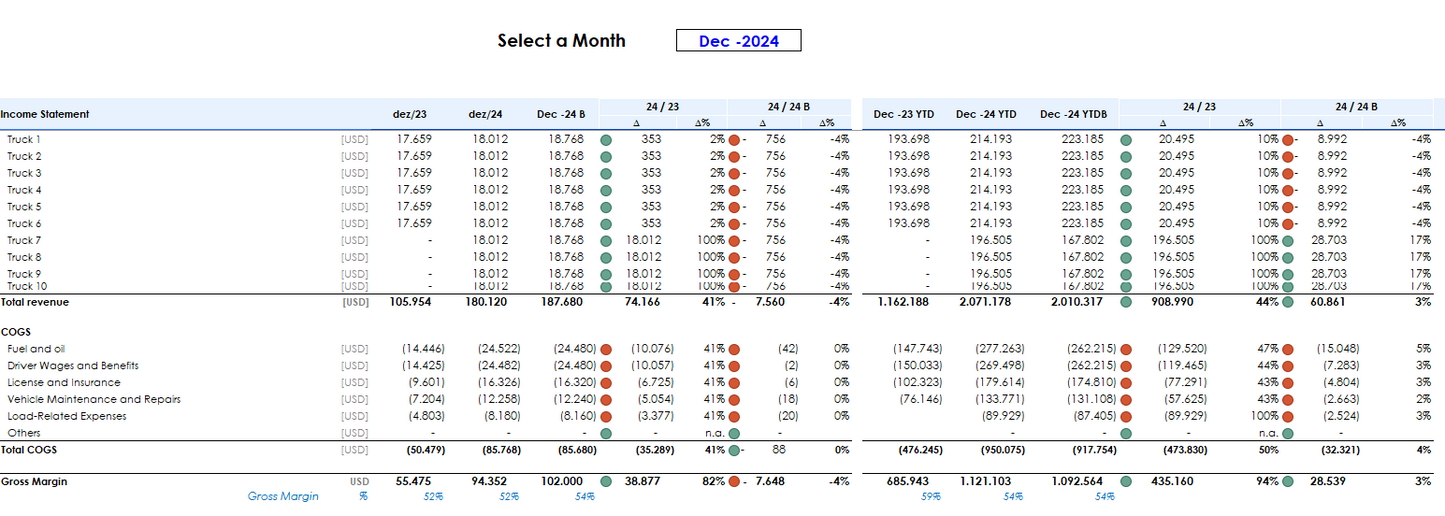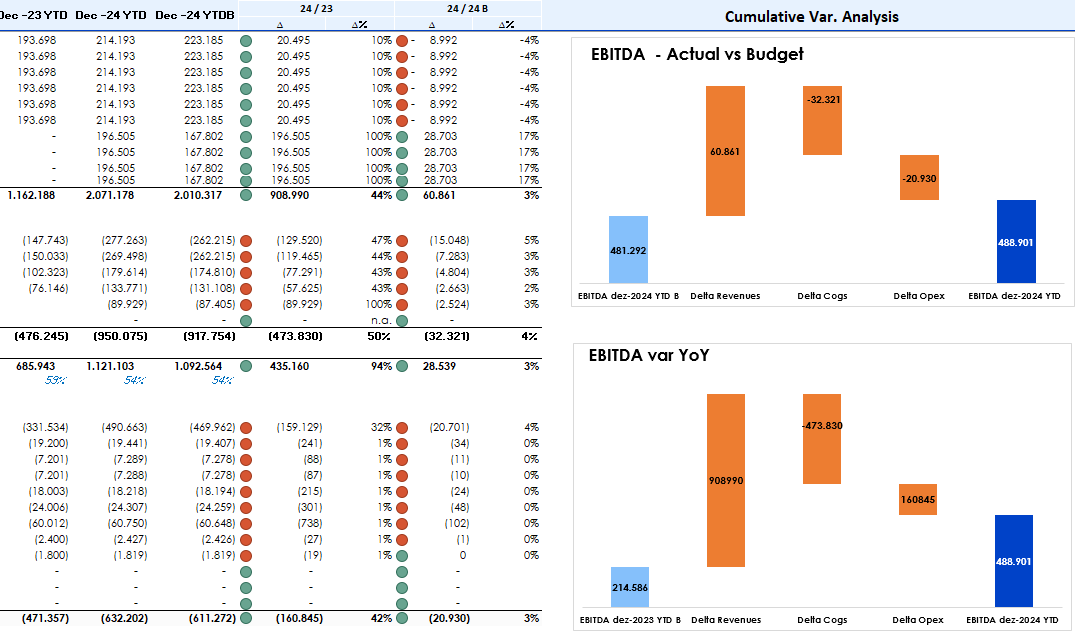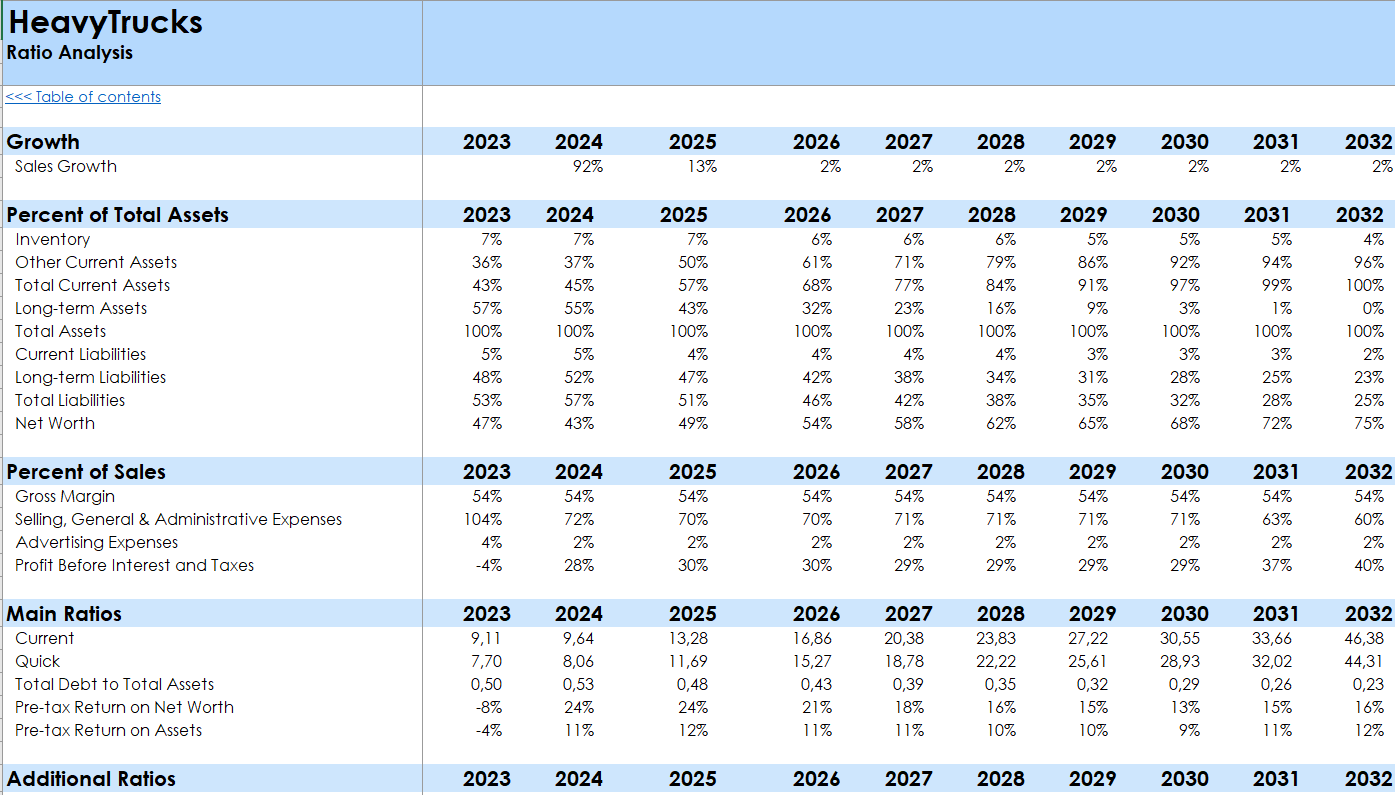Bizz View
Freight Trucking Company - Google Sheets
Freight Trucking Company - Google Sheets
Regular price
$35.00 USD
Regular price
$60.00 USD
Sale price
$35.00 USD
Unit price
per
Couldn't load pickup availability
The financial model for a Trucking Company Financial Plan is designed to help trucking company owners, and investors make informed decisions about their business. It provides a comprehensive analysis and projection of the company's financial performance, allowing users to assess the viability and profitability of their trucking operations.
How the Model Works:
Revenue: The trucking business generates revenue streams based on forecasting the average number of miles a truck will be driven and the rate per mile charged to customers. This can be estimated by analyzing historical data, market demand, and projected customer volumes.
Costs: The model includes standard expenses such as fuel costs, driver wages, vehicle maintenance and repairs, insurance, toll fees, and administrative expenses. Users can easily add, remove, or adjust costs for operational needs. These costs are demonstrated through "components" to understand how costs contribute to the overall expenses.
Investments: Forecasting balance sheet transactions for trucking company investments can be simplified using the model. Users can set the percentage of funds from loans, cash, or business equity in the assumptions sheet to determine the financing structure. This allows flexibility in setting up funding processes for acquiring trucks or other assets through loans or equity investments.
Comparing Budget to Actual Expenses: The model includes a sheet where users can compare the actual performance of their trucking business against the initial forecast. This feature enables users to assess their financial performance, identify deviations from the projected figures, and adjust their strategies and budgets.
The model can be customized with specific data and assumptions relevant to the trucking company, making it a valuable tool for revenue projection, cost management, investment planning, and performance analysis.
Key Features :
The financial model for a trucking company shares similar characteristics to the one mentioned above. Here are the key features adapted for the trucking industry:
Input Sheets: The model provides assumption sheets where users can input key financial data for their trucking business. These inputs include revenue assumptions, capital expenditures for truck purchases, operating expenses such as fuel and driver wages, startup costs, and other critical financial information. Users can easily input data in the designated blue font cells, while the rest of the model utilizes formulas and labels to calculate results.
Flexibility: The model is designed to be flexible and adaptable to accommodate changes in the trucking industry or cater to the unique needs of a particular trucking operation. Users can modify assumptions and variables to reflect shifts in market conditions, regulatory changes, or business-specific requirements.
Auxiliary Sheets: Green sheets within the model perform auxiliary functions such as financial projections, debt analysis, and working capital projections. These sheets provide additional insights and calculations without requiring users to input extra information.
Output Sheets: Blue sheets in the model act as output sheets, offering a detailed view of the trucking business's financial performance based on the provided assumptions. These sheets provide comprehensive financial statements, cash flow projections, profitability metrics, and other relevant financial data to evaluate the business's performance.
Overall, the financial model for a trucking company offers a user-friendly interface, allowing users to input data, perform calculations, and obtain valuable insights into the financial aspects of their trucking operation.
Model Structure:
1. Assumptions: This sheet contains all the assumptions that are used in the financial model, such as revenue assumptions, capex, opex, and startup costs.
2. Ops - Calculations of revenue, cogs, and Opex: This sheet contains the calculations for revenue, cost of goods sold (COGS), and operating expenses (Opex). The calculations are based on the assumptions provided in the Assumptions sheet.
3. Working Capital: This sheet calculates the business's working capital requirements, which is the money needed to run the business's day-to-day operations.
4. Debt Model: This sheet models the debt considering the funding assumptions.
5. Capex: This sheet models the capital expenditures required to start and grow the business, including the cost of equipment and property.
6. Mo-FS - Monthly Financial Statement: This sheet contains the monthly financial statements for the business, including the income statement, balance sheet, and cash flow statement. These statements are based on the calculations performed in the Ops and Capex sheets. (in this sheet in the Cash flow Section, the user can set up the dividend payout if needed it)
7. Actual: This sheet is used to input actual data as it becomes available. This allows the business owner to compare actual performance against the forecasted performance and adjust their strategy as needed (the expenses must be inputted as negative values).
8. Annual Financial Statements: This sheet contains the annual financial statements for the business, including the income statement, balance sheet, and cash flow statement. These statements are based on the monthly financial information in the Mo-FS sheet.
9. Summary - Executive Summary with Main Metrics: This sheet provides a summary of the primary metrics for the business, such as revenue, net income, and key ratios, allowing the business owner to assess the performance of the business quickly.
10. Breakeven Analysis: This sheet calculates the breakeven point for the business, which is the level of sales at which the company is neither making a profit nor a loss, allowing the business owner to understand the minimum sales needed to cover their costs.
11. Ratios - 20+ Ratios of All Kinds: This sheet provides a list of over 20 different financial ratios that can be used to assess the performance of the business. These ratios cover liquidity, profitability, debt, and activity.
12. Valuation Calculation: This sheet calculates the business's valuation using discounted cash flow; this allows the business owner to understand the potential value of their business and make informed decisions about its future.
13. Budget vs. Actual: This sheet compares the budgeted amounts and the actual amounts for the various financial metrics, such as revenue, expenses, and net income. The sheet also compares the actual amounts and the corresponding period from the previous year; this allows the business owner to understand how well the business is performing relative to their budget and historical performance.
14. Charts: The sheet also includes charts to help visualize the differences between the budgeted and actual amounts. These charts can help the business owner identify areas where the business is performing better or worse than expected and take action to address any issues.
How the Model Works:
Revenue: The trucking business generates revenue streams based on forecasting the average number of miles a truck will be driven and the rate per mile charged to customers. This can be estimated by analyzing historical data, market demand, and projected customer volumes.
Costs: The model includes standard expenses such as fuel costs, driver wages, vehicle maintenance and repairs, insurance, toll fees, and administrative expenses. Users can easily add, remove, or adjust costs for operational needs. These costs are demonstrated through "components" to understand how costs contribute to the overall expenses.
Investments: Forecasting balance sheet transactions for trucking company investments can be simplified using the model. Users can set the percentage of funds from loans, cash, or business equity in the assumptions sheet to determine the financing structure. This allows flexibility in setting up funding processes for acquiring trucks or other assets through loans or equity investments.
Comparing Budget to Actual Expenses: The model includes a sheet where users can compare the actual performance of their trucking business against the initial forecast. This feature enables users to assess their financial performance, identify deviations from the projected figures, and adjust their strategies and budgets.
The model can be customized with specific data and assumptions relevant to the trucking company, making it a valuable tool for revenue projection, cost management, investment planning, and performance analysis.
Key Features :
The financial model for a trucking company shares similar characteristics to the one mentioned above. Here are the key features adapted for the trucking industry:
Input Sheets: The model provides assumption sheets where users can input key financial data for their trucking business. These inputs include revenue assumptions, capital expenditures for truck purchases, operating expenses such as fuel and driver wages, startup costs, and other critical financial information. Users can easily input data in the designated blue font cells, while the rest of the model utilizes formulas and labels to calculate results.
Flexibility: The model is designed to be flexible and adaptable to accommodate changes in the trucking industry or cater to the unique needs of a particular trucking operation. Users can modify assumptions and variables to reflect shifts in market conditions, regulatory changes, or business-specific requirements.
Auxiliary Sheets: Green sheets within the model perform auxiliary functions such as financial projections, debt analysis, and working capital projections. These sheets provide additional insights and calculations without requiring users to input extra information.
Output Sheets: Blue sheets in the model act as output sheets, offering a detailed view of the trucking business's financial performance based on the provided assumptions. These sheets provide comprehensive financial statements, cash flow projections, profitability metrics, and other relevant financial data to evaluate the business's performance.
Overall, the financial model for a trucking company offers a user-friendly interface, allowing users to input data, perform calculations, and obtain valuable insights into the financial aspects of their trucking operation.
Model Structure:
1. Assumptions: This sheet contains all the assumptions that are used in the financial model, such as revenue assumptions, capex, opex, and startup costs.
2. Ops - Calculations of revenue, cogs, and Opex: This sheet contains the calculations for revenue, cost of goods sold (COGS), and operating expenses (Opex). The calculations are based on the assumptions provided in the Assumptions sheet.
3. Working Capital: This sheet calculates the business's working capital requirements, which is the money needed to run the business's day-to-day operations.
4. Debt Model: This sheet models the debt considering the funding assumptions.
5. Capex: This sheet models the capital expenditures required to start and grow the business, including the cost of equipment and property.
6. Mo-FS - Monthly Financial Statement: This sheet contains the monthly financial statements for the business, including the income statement, balance sheet, and cash flow statement. These statements are based on the calculations performed in the Ops and Capex sheets. (in this sheet in the Cash flow Section, the user can set up the dividend payout if needed it)
7. Actual: This sheet is used to input actual data as it becomes available. This allows the business owner to compare actual performance against the forecasted performance and adjust their strategy as needed (the expenses must be inputted as negative values).
8. Annual Financial Statements: This sheet contains the annual financial statements for the business, including the income statement, balance sheet, and cash flow statement. These statements are based on the monthly financial information in the Mo-FS sheet.
9. Summary - Executive Summary with Main Metrics: This sheet provides a summary of the primary metrics for the business, such as revenue, net income, and key ratios, allowing the business owner to assess the performance of the business quickly.
10. Breakeven Analysis: This sheet calculates the breakeven point for the business, which is the level of sales at which the company is neither making a profit nor a loss, allowing the business owner to understand the minimum sales needed to cover their costs.
11. Ratios - 20+ Ratios of All Kinds: This sheet provides a list of over 20 different financial ratios that can be used to assess the performance of the business. These ratios cover liquidity, profitability, debt, and activity.
12. Valuation Calculation: This sheet calculates the business's valuation using discounted cash flow; this allows the business owner to understand the potential value of their business and make informed decisions about its future.
13. Budget vs. Actual: This sheet compares the budgeted amounts and the actual amounts for the various financial metrics, such as revenue, expenses, and net income. The sheet also compares the actual amounts and the corresponding period from the previous year; this allows the business owner to understand how well the business is performing relative to their budget and historical performance.
14. Charts: The sheet also includes charts to help visualize the differences between the budgeted and actual amounts. These charts can help the business owner identify areas where the business is performing better or worse than expected and take action to address any issues.
